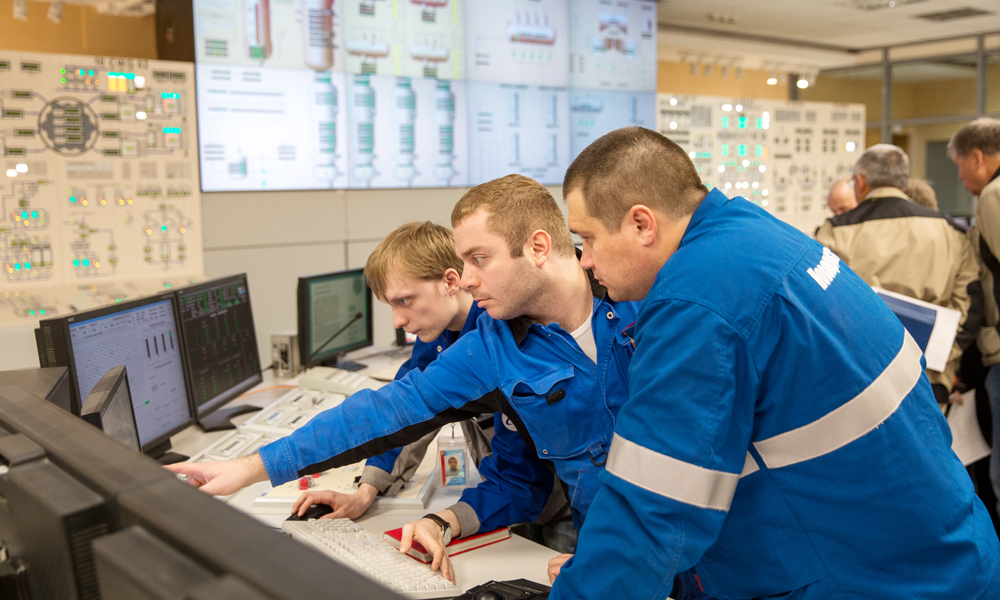
World’s Number One
back to contentsLast August, the VVER-1200 reactor at Unit 1 of Novovoronezh II was for the first time connected to the national power grid and began power generation. By the time the power unit was put in commercial operation, it had passed all the necessary tests and generated 1,691 million kWh of electricity. Its compliance with the project design, technical standards and statutory regulations, including power efficiency requirements, was certified by Russia’s Federal Service for Environmental, Technological and Nuclear Supervision (Rostechnadzor). “I am thankful to the Novovoronezh staff for their commitment to putting the reactor unit in operation and all the hard work they have done to prepare documents for the submission to Rostechnadzor,” said Vladimir Povarov, Director of the Novovoronezh Nuclear Plant.
Better than others
Novovoronezh II Unit 1 with the VVER-1200 reactor incorporates the AES-2006 design featuring a number of definitive advantages over the VVER-1000 reactor design. In particular, it provides for a 20% higher power capacity and a doubled service life (60 vs. 30 years) of its core components, a reactor vessel and a steam generator body. More important is that the new design is fully compliant with the post-Fukushima safety requirements.
The Russian AES-2006 design features an array of unparalleled safety systems. One of them is a core catcher, a unique safety device designed by Russian nuclear engineers to mitigate effects of a nuclear meltdown. Structurally, it has a cone-shaped body installed at the bottom of the reactor pit. In case of an accident, the core catcher medium mixes with the molten core materials and distributes them evenly inside the catcher body. The catcher can hold the molten core for an unlimited period of time, preventing nuclear materials from getting outside. The first ever core catcher was installed at the Russian-designed Tianwan Nuclear Power Plant in China.
Another advantage of the new design is the use of uranium gadolinium oxide fuel to enhance physical parameters of the nuclear reactor core. The possibility of using conventional fuel still exists, though. As compared to VVER-1000 reactors, the AES-2006 design features new monitoring and diagnostic systems for the equipment, primary loop piping and valves. The design also incorporates improved reactor core radiation and neutron monitoring systems. And finally, the new design provides for reduced downtime and improved capacity utilization, which is expected to reach 92%.
No human involvement
Passive heat removal is another unparalleled safety feature of the AES-2006 design. This technology allows for cooling of the reactor core in case of power outage without human involvement. The system adopts a natural circulation principle where an outdoor air (coolant) is sucked in by heat exchangers, then heats up and rises to the exhaust header on the top of the dome to be released into the atmosphere.
Financial benefits
New safety systems, increased service life of the primary equipment and improved automation solutions significantly reducing the need for manpower will almost double the cost efficiency of Novovoronezh II. “It should be noted that such outstanding cost efficiency is not achieved at the expense of safety. On the contrary, all the safety parameters are dramatically enhanced. At present, no one is surprised by a large number of safety systems. Good news is that there is a rising trend after the Fukushima disaster towards self-contained passive systems requiring no power or human control. Much progress has been made both in Russia and abroad in the development of such systems. It is worth mentioning that several systems are Russian know-how, particularly the core catcher, making the Russian design more attractive for customers and providing Rosatom with undeniable advantages in its effort to expand the portfolio of international nuclear construction contracts,” said Alexei Mayorov, First Deputy Chairman of the Federation Council Committee for Economic Policy.
Denis Kravchenko, Deputy Chairman of the Parliamentary Committee for Economic Policy, Industry, Innovative Development and Entrepreneurship: “The most advanced Unit with a Generation 3+ VVER-1200 reactor was put in commercial operation at the Novovoronezh Nuclear Power Plant. This is undoubtedly a huge milestone in the nuclear industry development. It proves that the industry keeps evolving, and our designers and engineers continue to hone their craft. And our position on the international market becomes more influential.”
No environmental impact
According to the environmental impact assessment, the commissioning of Novovoronezh II will not affect the environment. The new site is located in the Kashirskoe District of the Voronezh Region, only 900 meters away from the Novovoronezh nuclear plant. Over 80% of the territory is arable land, with the Don River flowing nearby. Comprehensive environmental surveys have been regularly conducted here since 1994.
FOR REFERENCE
Novovoronezh II was designed to replace the obsolete Novovoronezh nuclear power plant, the oldest commercial nuclear station built in the USSR. Construction of the Novovoronezh NPP began in 1958. The first power unit was brought online in 1964, with the other four units put in operation in 1969, 1971, 1972 and 1980 respectively. Three out of five reactors have been shut down by now and are in the process of decommissioning.




